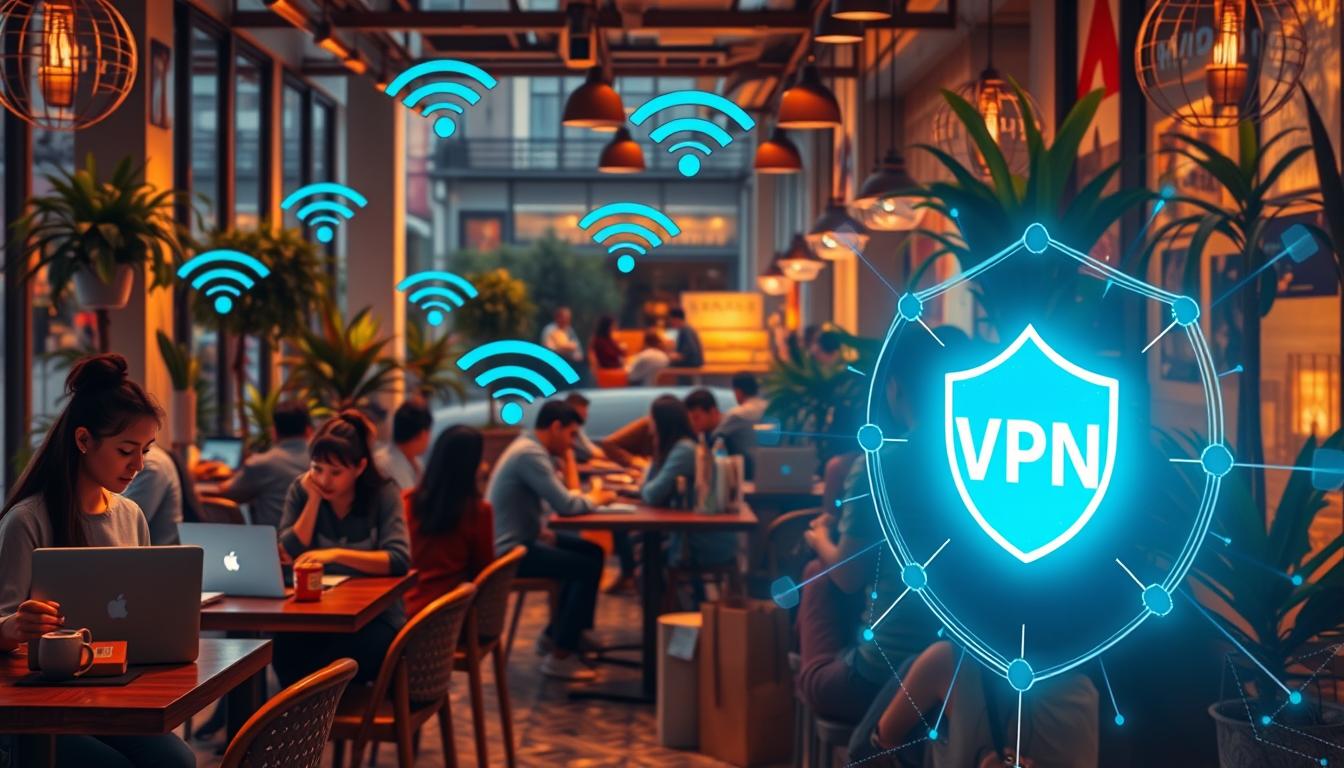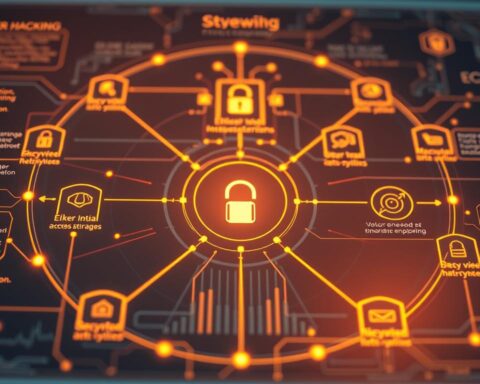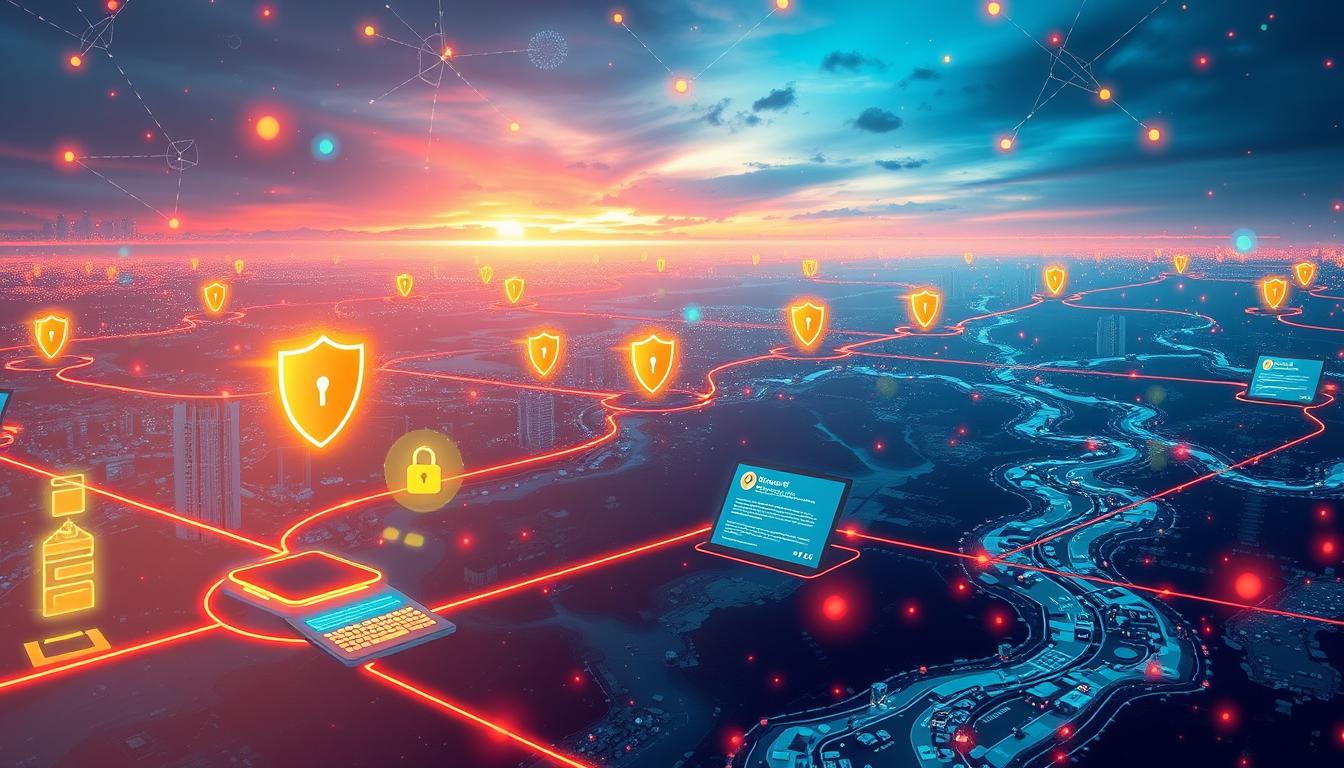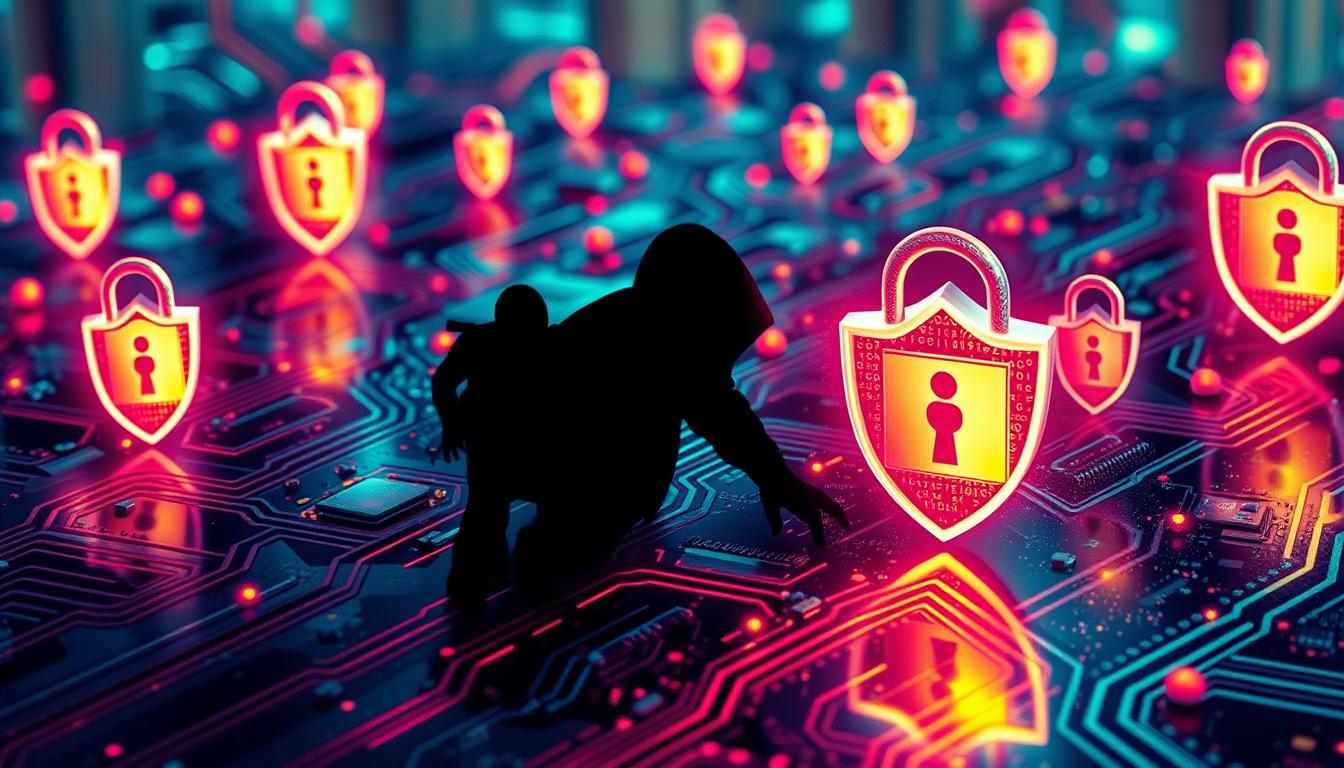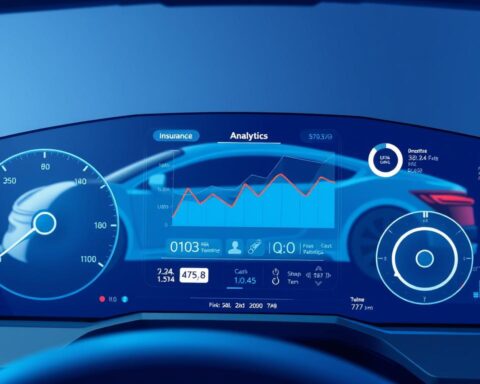Did you know 87% of internet users risk their info on free public Wi-Fi1? This shows how important it is to be careful online. Today, we’re focusing on how to stay safe with public Wi-Fi and Virtual Private Networks (VPNs). We’ll teach you how to protect your digital life when you’re out and about.
Wireless connections are everywhere today. It’s key to know about public Wi-Fi risks and how to avoid them. We’ll talk about the dangers of public Wi-Fi and how VPNs can help keep you safe. By the end of this, you’ll know how to use public networks without worrying about your data.
Key Takeaways
- Public Wi-Fi networks pose significant security risks to users
- VPNs create secure connections and encrypt data on public networks
- Understanding Man-in-the-Middle attacks is crucial for online safety
- HTTPS protocol and secure browsing practices are essential
- Mobile device protection strategies enhance overall security
- Avoiding financial transactions on public Wi-Fi is highly recommended
Understanding the Risks of Public Wi-Fi Networks
Public Wi-Fi networks are handy for staying connected, but they pose big cybersecurity risks. Almost half of Americans use Wi-Fi hotspots for financial deals and 18% for remote work. It’s key to know these risks2.
Types of Public Wi-Fi Networks
Public Wi-Fi networks are either secured or unsecured. Secured networks ask users to agree to terms, register, or enter a password. Unsecured networks, however, let anyone join without any checks, making them easy targets for hackers.
Common Security Vulnerabilities
Many public Wi-Fi networks use cheap routers without key security features. Over 60% of users might not use security measures, making them vulnerable to attacks2. Encryption, a vital security tool, is often turned off by default on these routers, leaving users open to data theft3.
Data Interception Threats
Hackers can take over a public Wi-Fi network in under 17 minutes2. They can grab user data in seconds on unsecured networks, getting access to personal and financial info, and even work data23. Man-in-the-middle attacks are common, letting hackers listen in on data sent over these networks3.
To keep your mobile data safe, using a Virtual Private Network (VPN) is a good idea when using public Wi-Fi2. This extra security can help lower your risk of falling victim to online threats in public areas.
Public Wi-Fi and VPNs: Staying Safe on the Go
In today’s world, public Wi-Fi is everywhere. It’s convenient but risky. A huge 75% of public Wi-Fi networks are not secure and can be attacked4. This makes 30% of users feel less safe when using it4.
Using public Wi-Fi can be dangerous. Hackers can steal your data with attacks like man-in-the-middle. They can also spread malware to your devices5. Even worse, they can take over a network in under 17 minutes2.
To stay safe, using a Virtual Private Network (VPN) is key. A VPN encrypts your data, keeping it safe on public networks. This is why 85% of mobile VPN users feel safer on public Wi-Fi4.
| Public Wi-Fi Risks | VPN Benefits |
|---|---|
| Data interception | Data encryption |
| Malware distribution | Malware protection |
| Identity theft | Anonymous browsing |
| Geo-restrictions | Bypass geo-blocks |
About 50% of Americans use Wi-Fi hotspots for financial stuff2. With a VPN, you can lower the risk of data breaches. Stay safe and enjoy public Wi-Fi.
Man-in-the-Middle Attacks Explained
Man-in-the-Middle (MITM) attacks are a big problem in cybersecurity. They happen when a bad guy gets between two systems, stealing important data.
How MITM Attacks Work
Hackers set up between your device and the server. They listen in and grab things like passwords and credit card numbers. Sadly, 70% of people use public Wi-Fi, and 46% think their data is safe6.
Detection and Prevention Methods
Finding MITM attacks is hard, but there are ways to stop them. Using a VPN can cut down the risk by 95% by encrypting data6. Also, over 80% of big websites use HTTPS now, making them safer6.
Real-world Attack Scenarios
MITM attacks are real and serious. In 2017, a big data breach at Equifax hit over 145.5 million Americans, with 2.5 million directly affected7. This shows how serious these threats are. Companies hit by MITM attacks might slow down, spend more to fix things, and lose trust from customers7.
“Effective user awareness and training can reduce susceptibility to MITM attacks by as much as 68%.”
To avoid MITM attacks, check if a website uses HTTPS before sharing sensitive info. Sadly, 33% of people don’t do this6. Being careful and using strong encryption can help a lot in fighting these cyber threats.
Essential VPN Features for Public Wi-Fi Security
Virtual private networks are key to keeping your data safe on public Wi-Fi. With 80% of public Wi-Fi connections being unsecured, the risk of data breaches is high8. Sadly, 50% of users don’t know their data can be intercepted on these networks8.
Good VPNs use strong data encryption like AES-256 and ChaCha20, which are top standards8. These methods can cut the risk of data interception by up to 90% on public Wi-Fi8. Strong encryption is key to keeping your sensitive info safe.
A kill switch stops data leaks if your VPN connection fails. Multi-hop connections boost your anonymity, and no-logs policies keep your online activities private. Split-tunneling lets you pick which traffic goes through the VPN, improving performance.
VPN Usage Statistics
Despite the dangers, only 1% of Americans use a VPN on public networks, compared to 2% in France and 6% in Germany9. This low use is worrying, given 81% of Americans often use public Wi-Fi hotspots9. Coffee shops, restaurants, airports, and hotels are especially risky for public Wi-Fi use9.
“Using a VPN is like having a personal bodyguard for your online data in the wild west of public Wi-Fi.”
Knowing these essential VPN features helps you make smart choices to protect your data on public networks. Home Wi-Fi is five times safer than public hotspots8. Make sure to pick a reliable VPN service with these important features to keep your online safety in check.
Secure Browsing Practices on Public Networks
Using public Wi-Fi safely needs certain practices. These steps help keep your data safe in risky places.
HTTPS Protocol Importance
The HTTPS protocol is key for secure browsing. It encrypts data, making it hard for hackers to get your info. Always use HTTPS sites when on public Wi-Fi. But, only 27% of users check for “HTTPS” before sharing sensitive info4.
Browser Security Settings
It’s important to set up your browser for safety. Turn on the ‘always use HTTPS’ option and manage cookies for better privacy. Adding Multi-Factor Authentication (MFA) requires more verification for account access10.
Safe Browsing Extensions
Safe browsing extensions can really help. HTTPS Everywhere and ad blockers make browsing safer. Yet, about 30% of people don’t use security on public Wi-Fi, risking data breaches4.
Following these practices can protect you from public Wi-Fi threats. Remember, you’re 24 times more likely to be attacked on unsecured public Wi-Fi than on secure ones4. Always be careful and keep your online safety in mind.
Mobile Device Protection Strategies
In today’s world, keeping your mobile devices safe is key. Cyber threats are everywhere, especially in public places. So, it’s vital to protect your smartphones and tablets well.
Smartphone Security Settings
Smartphones are always with us, often connecting to public Wi-Fi. To keep your privacy, turn off auto-connect for Wi-Fi and Bluetooth. This stops your device from joining risky networks11.
Always update your phone’s OS and apps to fix security holes. Also, use two-factor authentication for extra security12.
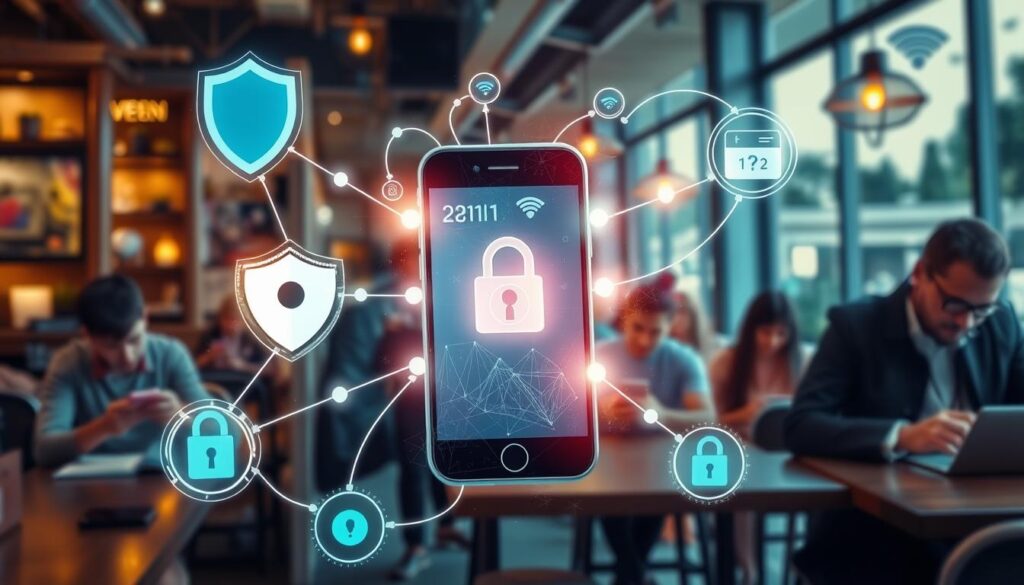
Tablet Safety Measures
Tablets need the same protection as smartphones. Encrypt your device and set up remote wipe. These steps keep your data safe, even if your tablet is lost.
App Permission Management
Be careful with app permissions to protect your data. Many apps ask for too much access. Only grant what’s necessary.
| Security Measure | Adoption Rate | Effectiveness |
|---|---|---|
| VPN Usage | 40% increase in last 2 years | High |
| HTTPS Connections | 75% of websites support | Moderate |
| Browser Security Extensions | 25% of users | High |
Think about using mobile security apps and built-in tools like Find My Device. These can help find, lock, or erase your device if it’s lost. By using these methods, you lower risks when using public Wi-Fi13.
Data Encryption Methods for Public Wi-Fi
Data encryption is key to keeping your online data safe, especially on public Wi-Fi. With cybercrime on the rise, it’s vital to know how to protect yourself. This is especially true since 1 in 5 people fall victim to cybercrime on public Wi-Fi14.
Encryption turns your data into a code that’s hard to crack. When using public Wi-Fi, choose networks with HTTPS. This adds an extra layer of security14.
Using a Virtual Private Network (VPN) is a top way to keep your data safe. VPNs make sure your data stays private by making it unreadable. Studies show that using a VPN can cut down data leak risks by up to 70% on unsafe networks15.
Here are some encryption methods to consider:
- End-to-end encryption for messaging apps
- File-level encryption tools for sensitive documents
- Encrypted email services
- Secure cloud storage solutions
Adding two-factor authentication (2FA) to your online accounts is also smart. It asks for a second form of verification, making it harder for hackers to get in14.
But, only 27% of people know how important using a VPN on public networks is. This shows a big gap in knowing how to stay safe online15. By learning about these encryption methods, you can make your online activities much safer on public Wi-Fi.
| Encryption Method | Description | Effectiveness |
|---|---|---|
| VPN | Secures internet traffic | Reduces data leak risk by 70% |
| HTTPS | Secure web browsing protocol | Makes data interception harder |
| 2FA | Additional verification step | Significantly reduces unauthorized access |
Advanced Security Measures for Remote Work
Remote work has seen a big jump, with U.S. telecommuters rising by 159% from 2005 to 201716. This change brings new cybersecurity hurdles. A shocking 67% of companies faced cyberattacks after starting remote work, showing the need for strong security17.
Corporate VPN Solutions
Virtual private networks (VPNs) are key for safe remote access. They make encrypted tunnels, crucial for protecting sensitive data and following rules18. Top VPNs use AES-256 encryption, kill switches, and no-log policies to boost user privacy18.
Remote Access Protocols
Good cybersecurity stops unauthorized access to sensitive data17. Multi-factor authentication (MFA) adds an extra security layer beyond passwords17. Zero Trust Network Access (ZTNA) makes sure only approved users and devices connect to secure networks17.
Security Policy Compliance
It’s vital to follow security policies. But, 26% of IT pros say their companies don’t have formal remote work security policies16. Regular software updates, endpoint security, and Network Access Control (NAC) are key parts of a solid security plan17.
By using these advanced security steps, companies can greatly lower the risk of data breaches. They can also protect their assets in the changing world of remote work1718.
Managing Digital Identity on Public Networks
Keeping your digital identity safe on public Wi-Fi is key today. With more online threats and privacy issues, it’s important to be careful. Public Wi-Fi spots, like cafes and airports, are often not secure. This makes them a target for hackers19.
Public networks can be vulnerable to eavesdropping and Man-in-the-Middle attacks19. To protect yourself, think about using a Virtual Private Network (VPN). Microsoft Defender now offers VPN protection for Windows, macOS, Android, and iOS20.
It’s scary to know that 70% of public Wi-Fi users don’t use VPNs, and 54% connect to unsecured networks21. This lack of caution can put your personal data at risk. To keep your digital identity safe:
- Use a VPN to encrypt your internet traffic
- Avoid accessing sensitive information on public Wi-Fi
- Enable two-factor authentication for your accounts
- Keep your software and security systems updated
Remember, 86% of people ignore network security, choosing convenience over safety21. Don’t be one of them. By following these tips, you can significantly reduce the risk of data breaches and unauthorized access to your accounts.
| Risk Factor | Percentage |
|---|---|
| Users not using VPN on public Wi-Fi | 70% |
| Users connecting to unsecured networks | 54% |
| Users ignoring network security | 86% |
Be proactive in managing your digital identity. With the right tools and knowledge, you can safely use public networks. This way, you can keep your privacy and security intact.
Financial Transaction Safety Guidelines
When using public Wi-Fi for financial transactions, be extra careful. Public networks are often not secure. This makes them a target for hackers who want to steal your personal info.
Banking Security Protocols
To keep your money safe, follow strict banking security rules. Always look for HTTPS and a padlock icon in your browser. These signs mean your data is encrypted and safer from theft2223. Also, use two-factor authentication (2FA) to make your accounts even more secure22.
Payment Protection Measures
When paying online, use virtual credit cards or secure payment sites. Always check your bank statements for any odd transactions22. Set up alerts for unusual activity to catch fraud quickly22.
Secure Online Shopping
For safe online shopping, choose well-known e-commerce sites. Avoid logging into sites that need passwords on public networks23. Remember, 25% of travelers have been hacked through public Wi-Fi abroad23.
- Use a Virtual Private Network (VPN) to reduce the risk of data interception22
- Create strong, unique passwords for each service22
- Keep your software and antivirus protection up-to-date22
- Back up your files at least once a week23
By following these tips, you can lower your risk of financial fraud and data theft on public Wi-Fi.
| Security Measure | Benefit |
|---|---|
| Two-Factor Authentication | Adds an extra layer of account security |
| VPN Usage | Reduces risk of data interception |
| Strong, Unique Passwords | Prevents over 80% of hacking-related breaches |
| Regular Software Updates | Protects against potential malware threats |
Best Practices for Wi-Fi Hotspot Selection
Choosing the right Wi-Fi hotspot is key for wireless security on public networks. Many users don’t realize the risks, with 73% connecting to public Wi-Fi without a VPN. This leaves their data open to hackers24. Not using HTTPS makes data breaches more likely25.
To stay safe on the go, follow these key guidelines:
- Verify network names with the establishment providing the service
- Use password-protected hotspots over open networks
- Consider personal mobile hotspots as a safer alternative
- Configure device settings to prevent automatic connections
About 30% of public Wi-Fi networks are unsecure, making them open to data interception24. Fake Wi-Fi networks, or “evil twins,” have risen by 41% in a year. They mimic real networks to trick users24.
To enhance your security:
- Use a VPN when connecting to public Wi-Fi, which can prevent data leaks in about 90% of scenarios if configured correctly25
- Enable two-factor authentication to reduce unauthorized access risk by approximately 50%25
- Manually select Wi-Fi networks to lower the risk of connecting to rogue hotspots by 60%25
- Check for HTTPS on important sites, reducing the likelihood of data interception by 70%25
By following these best practices, you can lower your risk of security threats. Make informed choices about connecting to public networks. Remember, public wi-fi and VPNs are essential for staying safe on the go.
| Security Measure | Risk Reduction |
|---|---|
| Using a VPN | 90% data leak prevention |
| Two-factor authentication | 50% unauthorized access reduction |
| Manual network selection | 60% rogue hotspot connection reduction |
| HTTPS usage | 70% data interception reduction |
Conclusion
As we finish our cybersecurity training on public Wi-Fi and VPNs, it’s clear we must stay alert and take action. Public Wi-Fi is convenient but risky, with about 80% of hotspots lacking proper encryption26. Cybercriminals take advantage of this, using unsecured networks for 60% of their attacks26.
The risks are high, with 43% of identity theft victims losing money26. Yet, many are unaware or unprepared. Shockingly, 75% of users don’t use a VPN on public Wi-Fi26, and 80% ignore cybersecurity risks27. This is concerning, as 54% of hijacked sessions on public Wi-Fi can expose sensitive info27.
But there’s good news. Simple steps can greatly improve our safety. Using a VPN can cut data interception risk by up to 95%2627. Regular software updates and two-factor authentication can stop 30% of attacks and reduce unauthorized access by 99%, respectively27. Let’s make digital safety a priority by using these essential cybersecurity practices on public Wi-Fi.
FAQ
What are the main risks of using public Wi-Fi networks?
Using public Wi-Fi can lead to data theft and malware attacks. Cybercriminals can easily intercept your data because these networks are often not secure. This makes it simple for them to steal your information or spread viruses.
How does a VPN protect me on public Wi-Fi?
A VPN creates a secure tunnel for your internet. This means hackers can’t intercept your data. It also hides your IP address and encrypts your online activities, making it hard for hackers to get your sensitive info.
Are all public Wi-Fi networks equally risky?
No, not all public Wi-Fi is the same. Networks that require a password are safer than open ones. But, even secure networks can be at risk. So, it’s wise to use a VPN for extra protection.
What features should I look for in a VPN for public Wi-Fi use?
Look for strong encryption like AES-256 and a kill switch. Also, check for a no-logs policy, DNS leak protection, and multi-factor authentication. A big server network and fast connection speeds are also key for a good experience.
How can I identify a secure website when using public Wi-Fi?
Check for “https://” and a padlock icon in the URL. These signs mean the site uses encryption. You can also use HTTPS Everywhere to ensure secure connections.
Is it safe to access my bank account on public Wi-Fi?
It’s not safe to access your bank on public Wi-Fi. Use a VPN and make sure you’re on your bank’s official app or site. It’s better to use your mobile data for these transactions.
How can I protect my mobile devices on public Wi-Fi?
Keep your devices updated and use a VPN. Turn off auto-connect and manage app permissions. Use mobile security apps and avoid sensitive info on public Wi-Fi.
What is a man-in-the-middle attack and how can I prevent it?
A man-in-the-middle attack happens when hackers intercept your communication. To avoid this, use a VPN and make sure sites use HTTPS. Avoid sensitive info on public Wi-Fi and watch for suspicious certificate warnings.
How do I know if a public Wi-Fi hotspot is safe to use?
Check the network name with the place it’s provided by. Use password-protected networks and consider Wi-Fi security apps. Always assume public Wi-Fi is not safe and take precautions.
Can I use my work laptop safely on public Wi-Fi?
Yes, but be careful. Use your company’s VPN, keep software updated, and use strong passwords. Avoid sensitive company data on public networks when you can.
Source Links
- Top Tips To Stay Safe On Public Wi-Fi | MetaCompliance – https://www.metacompliance.com/blog/security-awareness-training/top-tips-to-stay-safe-on-public-wi-fi
- The Dangers of Using Public Wi-Fi (and How To Stay Safe) – https://www.aura.com/learn/dangers-of-public-wi-fi
- The Risks of Public Wi-Fi and How to Stay Safe – https://globalcybersecuritynetwork.com/blog/risks-public-wi-fi-how-stay-safe/
- Public Wi-Fi security tips – https://www.verizon.com/about/blog/using-public-wi-fi-safely
- Public Wi-Fi: An ultimate guide to the risks + how to stay safe – https://us.norton.com/blog/privacy/public-wifi
- How to Prevent Man-in-the-middle Attacks – 5 Steps – https://teampassword.com/blog/man-in-the-middle-attack
- Man-in-the-Middle (MITM) Attack: Definition, Examples & More | StrongDM – https://www.strongdm.com/blog/man-in-the-middle-attack
- Wi-Fi VPN: protect yourself on public Wi-Fi – Surfshark – https://surfshark.com/blog/wifi-vpn
- Safe public Wi-Fi with a VPN – https://nordvpn.com/blog/securing-public-wi-fi/
- How to Safely Connect to Public Wi-Fi While Traveling | McAfee Blog – https://www.mcafee.com/blogs/tips-tricks/how-to-safely-connecting-to-public-wi-fi-while-traveling/
- Public Wi-Fi Safety: How to Stay Safe Online | IPVanish – https://www.ipvanish.com/blog/public-wifi-safety/
- Traveling Securely: A Comprehensive Guide to Protecting Your Digital Footprint While on the Move – National Cybersecurity Alliance – https://www.staysafeonline.org/articles/traveling-securely-a-comprehensive-guide-to-protecting-your-digital-footprint-while-on-the-move
- Stay safe on your Android phone while using free public Wi-Fi – https://www.computerworld.com/article/1665693/stay-safe-on-your-android-phone-while-using-free-public-wi-fi.html
- Stay Safe on Public Wi-Fi: 11 Tips to Protect Your Data and Privacy – https://blog.gantsystems.com/stay-safe-on-public-wi-fi-11-essential-tips-to-protect-your-data-and-privacy
- Secure Public Wifi Connection using VPN – https://community.spiceworks.com/t/secure-public-wifi-connection-using-vpn/759628
- How to Maintain Security When Employees Work Remotely – https://global.hitachi-solutions.com/blog/working-remotely-security-tips/
- VPN Security Best Practices for Remote Work | Traqq Blog – https://traqq.com/blog/remote-work-and-vpns-for-cybersecurity/
- Key Considerations for Using a VPN While Working From Home – Parachute – https://parachute.cloud/what-to-know-about-using-a-vpn-when-working-from-home/
- What You Can Do to Stay Safe When Using Public Wi-Fi Networks — PCS Technology – https://www.pcs-sf.com/blog/what-you-can-do-to-stay-safe-when-using-public-wi-fi-networks
- Defender VPN Safer public Wi-Fi – https://techcommunity.microsoft.com/blog/microsoftsecurityandcompliance/keep-your-online-activity-safer-on-public-wi-fi-with-microsoft-defender-for-indi/4251376
- Tips for safely using public Wi-Fi – https://watech.wa.gov/tips-safely-using-public-wi-fi
- How to Safely Use Free Public Wi-Fi for Banking Transactions? – https://www.hdfcbank.com/personal/resources/learning-centre/vigil-aunty/precautions-while-using-public-wi-fi-for-banking-transactions
- How to stay safe on public Wi-Fi – https://www.komando.com/tips/cybersecurity/steps-to-safely-use-public-wi-fi/?srsltid=AfmBOoosB-0HrQ-imCAT3JtXPDkRpW3WjTna4Nx31zW02mc-fvbYVf-g
- Protect Yourself When Using Public Wi-Fi – https://www.att.com/support/article/wireless/KM1000793/
- Staying secure on public WiFi? – https://community.spiceworks.com/t/staying-secure-on-public-wifi/740910/1
- VPNs and Public Wi-Fi: Staying Safe on the Go – WorldVPN – https://blog.worldvpn.net/2023/05/05/vpns-and-public-wi-fi-staying-safe-on-the-go/
- Understanding the risks of public Wi-Fi and how to stay protected – https://www.maddyness.com/uk/2024/02/17/understanding-the-risks-of-public-wi-fi-and-how-to-stay-protected/
